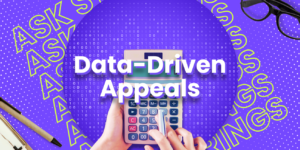Data, Data, Data. It seems we just can’t avoid hearing about it these days. Recent events like the implementation of the GDPR in Europe, and the exposure of Facebook’s data mining practices have brought attention to how powerful data truly is. However, the best fundraisers have known the impact a data-driven approach can have for some time.
Data is the most effective tool nonprofit organizations use to create compelling personalized content. After all, how can you make something feel personal and individualized if you know nothing about your audience? Continue reading to learn about the data-driven strategies we use to improve the value of our clients’ communications.
“I Have That Information Somewhere…”
First, let’s explore some of the common reasons why organizations struggle to adopt a data-driven strategy. One of the major problems we find when clients want to start using data in their communication efforts isn’t a lack of information. However, the problem is that valuable data is stored in many different places. We get it. You are always collecting information from different sources, so keeping up with good data hygiene can be daunting.
But if you have your data siloed into three different spreadsheets, stored in voicemails, and scattered in handwritten notes, you can’t comprehend what your data is trying to tell you. Furthermore, you cannot execute a data-driven campaign with specific goals, like recapturing lost donors, if you don’t know what information is current and accurate. Though it seems like an impossible task, organizing this information into a single database is your best bet. You may even want to delegate one person within your organization to maintain your database.
Does Your Organization Value Data?
If your organization is hesitant to adopt a data-driven strategy, you may need to convince your nonprofit’s leadership of the impact data has on your bottom line. Everyone needs to be on the same page when it comes to determining data’s role in your outreach strategy.
We know fundraising appeals are a costly investment. However, without data, it is impossible to determine your ROI. Managing your data, the right way will allow you to answer questions like, did we recapture any lapsed donors, or, was there an increase in first time gifts? By using data to answer these questions, you can tell how your campaign is going, beyond the scope of money raised.
The Power of a Data-Driven Approach
For example let’s say your organization sends out a mailer to your entire donor base. The mailer includes a PURL directing them to a personalized giving page. Some people will use the PURL and donate. Others will visit their personalized page but leave before actually making a gift. Then, there is a third group, that will never follow the PURL, and likely dismissed the giving opportunity in seconds.
This strategy gives your organization insight into who donated already and who did not show any interest (those who did not follow the PURL). Likewise, you will know who followed the PURL, but stopped short of donating. This group is engaged enough to want to learn more about your nonprofit. Unfortunately, they stopped just short of leaving a gift. Targeting this segment is just one of many ways you can utilize a data-driven approach.
Nevertheless, if you don’t have the necessary data and tools in place, you won’t be able to develop an effective secondary engagement strategy.
However, before you can start thinking about the specifics of your fundraising plan, you will need to make sure your organization understands the value of a data-driven strategy. You will also need to ensure the data at your disposal is organized and accessible.
Don’t Sink, Swim!
Without the building blocks in place, you will find it difficult to truly learn about your donor base from the information you have collected. If you jumped off a diving board without knowing how to swim, chances are you would drown. The same theory applies when you are ready to start thinking with data. If you jump right in without taking the necessary steps to prepare, you will quickly find yourself in way over your head.
Therefore, we’ve designed our next four blog posts in this series to be your guide. Hopefully, a month from now, you will have everything you need to know to develop and execute an effective data-driven fundraising plan. The next post in the series will focus on some lead generation strategies to help you gather even more data. We will then turn our focus to data security, ways to apply the data you’ve collected, and how to perform a data audit. Stay tuned!







